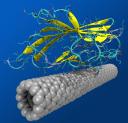 Infection by adenovirus is initiated when Knobs (globular protein domains) on the virus periphery bind to a CAR (Coxsackie-Adenovirus Receptor) membrane protein of the host cell. Experiments [Nano Letters 7: 3086-91(2007)] showed that CAR-Knob binding can be detected with single wall carbon nanotube (SWCN) field effect transistors covalently functionalized with CAR. Molecular dynamics (MD) computer simulations are employed to obtain atomic level understanding of the structure and properties of these devices. Covalently attached CAR protein forms a stable complex with SWCN retaining its biologically active structure. Broader Impact: New generations of biomolecular sensors will providekey advances for environmental safety, medical diagnostics, and homeland security. Hybrid systems integrating SWCN and biomolecular receptors are ideal because of their small size and exceptional physical properties. Until now, detailed modeling of the hybrid structure and sensing mechanisms of these devices has been lacking. MD simulations yield atomic level pictures of such devices. Synergistic coupling of experiment and MD simulation is going to be crucial to the future progress of this technology.
Infection by adenovirus is initiated when Knobs (globular protein domains) on the virus periphery bind to a CAR (Coxsackie-Adenovirus Receptor) membrane protein of the host cell. Experiments [Nano Letters 7: 3086-91(2007)] showed that CAR-Knob binding can be detected with single wall carbon nanotube (SWCN) field effect transistors covalently functionalized with CAR. Molecular dynamics (MD) computer simulations are employed to obtain atomic level understanding of the structure and properties of these devices. Covalently attached CAR protein forms a stable complex with SWCN retaining its biologically active structure. Broader Impact: New generations of biomolecular sensors will providekey advances for environmental safety, medical diagnostics, and homeland security. Hybrid systems integrating SWCN and biomolecular receptors are ideal because of their small size and exceptional physical properties. Until now, detailed modeling of the hybrid structure and sensing mechanisms of these devices has been lacking. MD simulations yield atomic level pictures of such devices. Synergistic coupling of experiment and MD simulation is going to be crucial to the future progress of this technology.